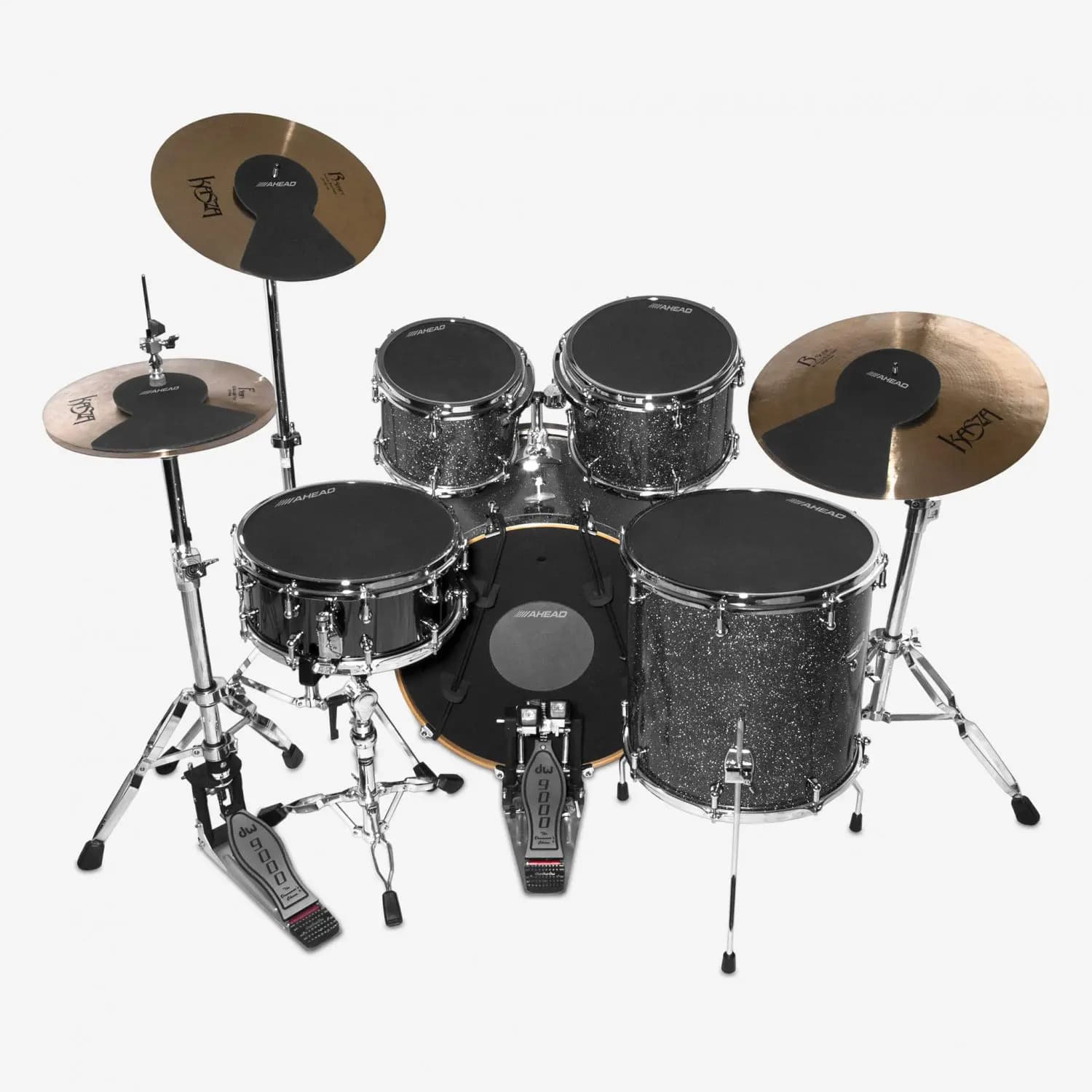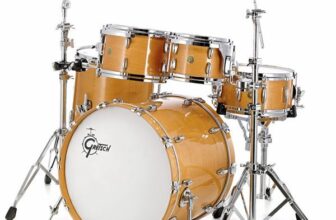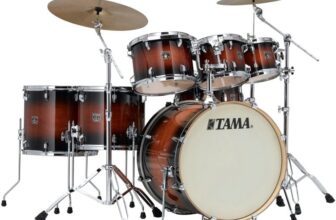Drums are one of the loudest acoustic instruments and making them quieter will be a part of your drumming experience.
Luckily, there are many ways of doing this, even if you are not in a situation of buying a lower volume drum kit.
From days of researching to my years of experience, I tried almost every single thing you can imagine.
I chose to make a list of my top 6 ways how to make drums quieter including DIY projects and cost-effective alternatives. Let’s check them.
7 Ways to Make Drums Quieter
- Drum mutes
- Mesh drum heads
- Quiet drumsticks
- Dampen drums
- Soundproofing the apartment
- Gel pads
- Tone rings

1. Drum mutes
- Price: from $25 a piece
- Time to set up: less than one-minute
- Volume reduction: up to 70%
Drum mutes are rounded pads made of non-slip rubber material. They are available in different sizes and are intended to be placed directly on the drum head in order to reduce the sound. However, they will not mute the sound in total.
As you strike the pads, you’ll still hear the tapping sound from your drums. They will reduce approximately 70% of the total sound, which is pretty incredible.
They are a tempting alternative for acoustic musicians since they are quite cheap and highly effective at drum kit noise reduction. With a good soundproofing room and a quality set of drum mutes, you can play your drums almost anywhere.
Once you place them and start drumming, the first thing you’ll notice is that they change the sound of each drum to a dull thud. It takes some getting used to it, but the drums still have their own distinct pitches.
Also, stick response is limited since the rubber absorbs a significant amount of the natural rebound of the drum, making it harder to develop dynamics, buzz rolls, ghost notes, and so on.
This means you won’t be able to play with brushes since the rubber surface will grip them.
However, you can add a covered practice pad over the drum, and this will readily solve this problem.
When playing hard or fast, the lower rebound forces you to work a little harder. This can actually benefit muscle growth for endurance when playing without the mutes.

2. Using mesh drum heads
- Price: from $15 a piece
- Time to set up: around 30 minutes for all drums in the set
- Volume reduction: up to 80%
If you want to reach that quieter tone on your acoustic set, replace your drumheads with mesh. As I mentioned above, mesh heads are much quieter, more responsive, and more sensitive, so it is a perfect setting for your playing.
The replacement is very easy. The first thing you need to do is to use the drum key to remove the tuning rods. When you do that, remove the hoop and remove the old drumhead. It is a good idea to whip off the dirt of your shell edges once you remove the drumhead.
Place your new mesh drumhead on the shell, making sure both sides meet the edge. Screw each tuning rod into the drum with your fingers until you can’t make them any tighter. When you finish that, you are ready to tune your drum. It is that easy!
Also, mesh kits have a realistic drum size, such as the ones on acoustic drum sets. This means they’re an excellent choice if you switch between an acoustic and electronic set. It also implies that you won’t have to adjust your technique or accuracy.

3. Using quiet drumsticks
- Price: $25
- Time to set up: None
- Volume reduction: up to 50%
Quiet drumsticks or better known as silent sticks, can reduce volume by up to 80%. The most popular quiet drumsticks are Adoro silent drumsticks which can help soften the sound of the drums while you play.
They are great for playing e-drums, worship, pad, and band practice, and overall, they are suitable for playing on any surface.
Silent drumsticks lower battery volume by -4 to -9 dB compared to standard drumsticks. The tips of these drumsticks are more flexible, so the contact between the stick and the pad is reduced.
Also, they are much lighter compared to regular wooden drumsticks. However, this does not affect the rebound. On the contrary, thanks to the impact-resistant polycarbonate shaft, the rebound of these sticks is amazing.
Another great pair of quiet drumsticks is Ultra-Tones sticks from Lidwish Solutions. With these quiet drumsticks, around half of the noise of the drums is reduced. The energy from each stroke is partially transmitted into the stick by flexing these drumsticks, resulting in quieter sounds.
Aside from the quiet playing, they bounce almost as well as standard drumsticks. This is extremely important because, without the bounce, I wouldn’t even consider using them.

4. Dampen drums
- Price: Free
- Time to set up: under 10 minutes
- Volume reduction: up to 30%
Dampening is a process that reduces the volume of a drum or drumhead, aiming to deliver less drum noise, tone, overtones, ringing, sustain, and high-pitch frequencies.
It is a perfect solution to make drums quieter, reduce ringing, and achieve a specific drum sound. Different methods of drum dampening can provide different results, from minor modifications to complete drum muffling.
To achieve a beautiful drum sound, various methods can be used, such as using blankets, cloth, pillows, tape, or any suitable material.
Placed towels on top of drums and cymbals can suppress drum noise, while larger blankets or towels can reduce bass drum loudness. Sheets between the bearing edge and drumhead heads can also help reduce loudness.
A pillow on the bottom of the drum can provide more control over airflow and resonance without ruining the sound. If the sound is not good, move the pillow until it is in the perfect position, checking if the sound is as desired and keeping it away from the batter head.
By understanding how different methods function, you can use them to achieve a beautiful drum sound.

5. Soundproofing the room
Another thing that you can try to do is to soundproof your apartment.
Here are a couple of soundproofing solutions to control the room’s acoustics:
- Acoustic membranes or acoustic mineral wool
- Plexiglass/drum shields
- Drum curtains
- Wall absorbers for drums/acoustic wall panels
- Drum diffusers

Use sound-absorbing materials like acoustic membranes or acoustic mineral wool.
- Price: $1.40–$2.10 per square foot
- Time to set up: couple of days
- Volume reduction: up to 60%
Place them on all of your walls, including ceiling and doors. Doing this will stop the sound vibration from traveling outside the room you are in and prevent the sound from bouncing around the room. Your neighbors will thank you later!
If you think that’s too much work for you – and it can be, I won’t lie, you can get plexiglass as a substitute.

Use plexiglass around a drum set
- Price: from $250
- Time to set up: 5 minutes
- Volume reduction: up to 30%
This is also a great solution since it won’t cost you much, it won’t take anything of your time regarding the placement and it will absorb and reduce the drum sound on the satisfied level since it won’t let it travel across the room so much.
I must emphasize drummers mostly use plexiglas in live circumstances rather than in apartments.

Use soundproof curtains
- Price: from $18
- Time to set up: 25 minutes
- Volume reduction: up to 50%
When it comes to soundproof curtains they cannot make your drums sound less loud, but they can stop from sound traveling outside the room you are playing in. This means that they are effective in reducing the echo rather than reducing the decibel level of sounds entering the room. You can put their curtains on your windows but also on your walls as well.

Use wall absorbers
- Price: from $14
- Time to set up: over an hour
- Volume reduction: up to 50%
Wall absorbers for drums or also known as acoustic wall panels are perfect for studios but are also suitable for your drum room.
They are suitable for both walls and floors and come in different sizes and thicknesses but are also pretty affordable options.
These panels are usually made of fabric, fiberglass, and cellulose while some panels are also made of foam.
Their main job is to reduce the amount of noise that travels through the room as well as open space. They are also designed to block sound transmission as well as reduce echo and reverberation.

Use sound diffusers
- Price: from $30
- Time to set up: over an hour
- Volume reduction: up to 30%
Room diffusers are air capacity terminals. They are made for delivering and ventilating conditioned air in a place where you play. t works by reducing the air duct velocity by increasing the static pressure.

6. Gel pads
- Price: from $9
- Time to set up: a couple of seconds
- Volume reduction: up to 20%
Gel pads are little, usually rounded pieces of sticky gel that you can apply anywhere on your drums as well as cymbals. These little wonders are very versatile.
They are not only great for reducing the drum sound but are perfect for removing overtones, reducing sustain, and gaining puncher sound. The most popular gel pad is Moongel and they are available in any instrument store and even Amazon.
Here’s how to apply your Moongel: Run your finger along the edge of your drum while you strike with your drumstick with every move. Do it until you find the place where the overtones are the loudest.
Once you locate it, just place the Moongel there. Another thing you can do is place your Moongel or in fact, any other gel you want on the resonant head. Placing it more toward the center will reduce the sustain and higher pitches even more.
Gel pads are a pretty inexpensive investment, especially because you can use them over and over again. Make sure they stay clean from dust, hair, and other sticking derbies since they have a tendency to collect them easily.
Even if that happens just wash them thoroughly with just water. Also, be aware of colored gel pads since they can leave stains on your drums.

7. Drum rings
- Price: from $12
- Time to set up: couple of seconds
- Volume reduction: up to 20%
Tone rings, e-rings, o-rings, muffing, or dampening rings are plastic rounded rings placed around the edge of your drumhead. They have many names, so do not get confused, they are all the same thing.
They sit on top of the drum heads, usually half an inch to two inches in diameter. Their job is to cut out necessary overtones and reduce the sustain. This lowers the drum volume and delivers a more focused drum sound.
A ring will weigh around the drum head’s edge which will result in lowering the pitch of the drum. Thanks to such a position of a ring, this will also reduce the amount of sustain.
Because of this, your drums will be less loud, more focused, and clearer. Shorter, punchier notes also sound better when playing along to tracks through headphones.
Remo and Evans are one of the best manufacturers of drum rings. Whichever you choose you won’t make a mistake with it.
Frequently asked questions
Why are drums so loud?
Acoustic drums do not have volume knobs, so the harder you hit, the louder they get. However, drums are still loud even if you do not hit that hard.
This is because the upper membrane resonates with the lower one, which results in a loud sound. Depending on the wood, they can be more or less loud.
Are drums too loud for house?
Drums are loud and without proper isolation they can be too loud outside your residence. In fact, they can be very loud for a row, terraced houses, duplexes, and semi-detached houses.
How many dB is a drumset?
Acoustic drum sets range from 90 to 130 decibels. To make it easy to understand – this is equivalent to being 50 feet away from a military jet taking off.
Conclusion
These were my top seven ways how to make drums quieter. If you are on a budget DIY methods can really help with volume reduction.
You can combine stuffing drum bass with covering the rest of the drums with a piece of cloth with low-volume cymbals and quiet drumsticks. For additional protection, you can use plexiglass but that will cost you some money.
There are many, many ways to make your drum kit quieter – but they can’t be silent. Remember this instrument is meant to be loud – that’s the beauty of it!
My name is Denis. I am a drummer, percussionist, music enthusiast, and blogger. Drums have been my passion for 15 years now. My idea is to write about the things I like and I am interested in. I want to share my drum passion with fellow musicians who walk, talk, and breathe drums.






